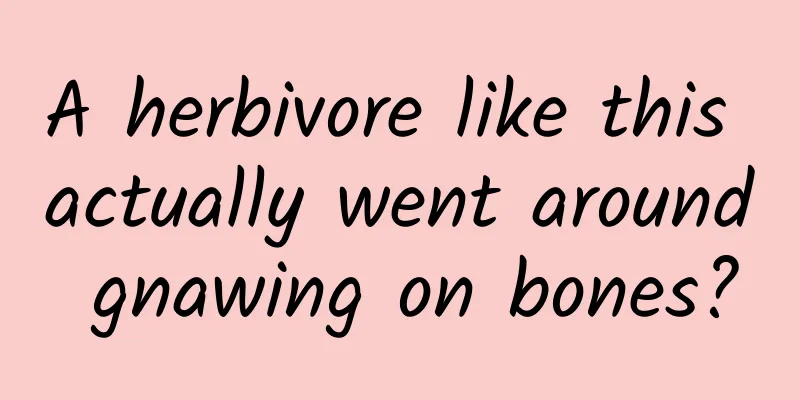A herbivore like this actually went around gnawing on bones?

|
What do you think it's doing? Image credit: Welgevonden GameReserve Whistling with a bone in your mouth? Or playing with a bone in your mouth? No! It is sucking the bone marrow, just like when you wear disposable gloves and grab a big bone to suck the delicious bone fat inside. Isn't it scary? Of course, the bone the giraffe eats may not be as delicious as the one you eat. The bone in its mouth was taken from a dried corpse that had been dead for ten days, and it was not heated to make soup, so it did not have that slippery and greasy taste. This photo was taken by Christiaan Swanepoel at the Welgewinden Wildlife Reserve. You might think that this scene was captured by the photographer after ten days of squatting on the savannah. It is not. This may be a rare scene for everyone reading this article, but in fact, giraffes sucking bone marrow is very common in the wild, you just don't pay much attention to it. The photo below was taken in 2017, showing a giraffe gnawing on a buffalo bone. Image source: national geographic Another photo was taken in 2018 at an unknown location. This giraffe holds an antelope skull in its mouth. Image credit: GalacticConquest This is a screenshot of a video shot in August 2018 at Tambe Elephant Park in KwaZulu-Natal, South Africa. A giraffe is with its companions, and it is holding a rotten buffalo head in its mouth. Interested friends can search for the video online to watch it. Image source: baobab3ful There are many more photos like this, so I won’t post them here. I just want to say that this is really quite common in the African savannah. Why would a normal herbivore not eat leaves but instead gnaw on bones? In order to survive and for nutrition. It is not enough for giraffes to eat only vegetarian food, because leaves lack some mineral elements necessary for giraffes , such as calcium and phosphorus. Otherwise, how can they grow so tall? Your mother always urges you to drink more milk, otherwise you won't grow taller, because milk contains calcium! Giraffes have such long necks, and if they don't have milk to drink, how can they not chew some bones to supplement calcium! As early as 2013, scientists published a paper in the Journal of Archaeological Science saying that giraffes not only suck bone marrow, they also often gnaw on deer antlers, cattle horns and ivory. There is a technical term for this behavior: osteophagia. Not only giraffes, many herbivorous animals have this "habit", such as the bull below, which is gnawing on the bones of its own kind. Image source: Wikipedia Some herbivores eat more bones, while others eat less. For example, a particularly tall giraffe might be more likely to eat bones than a shorter giraffe, for obvious reasons: taller giraffes have heavier bones and therefore need more calcium. Giraffes don't have the conditions to make soup with big bones, nor do they know how to pick out the marrow with chopsticks. Bones are hard, so they can only chew the bones bit by bit, breaking them into small pieces, and then dissolving the nutrients with saliva. When they are almost done, they throw them aside. Image source: References Scientists have also discovered that the gnawed bones only have scratches from teeth marks, so to be precise, giraffes do not eat bones, but scrape them bit by bit with their teeth... As for why giraffes sometimes hold bones in their mouths without chewing them? Image source: flick Scientists say: Maybe it's boredom. References: [1] Cáceres I, Esteban-Nadal M, Bennàsar M, et al. Osteophagia and dental wear in herbivores: actualistic data and archaeological evidence[J]. Journal of archaeological science, 2013, 40(8): 3105-3116. This article is produced by Science Popularization China, produced by Su Chengyu, and supervised by the Computer Network Information Center of the Chinese Academy of Sciences The cover image of this article is from the copyright gallery, and the image content is not authorized for reproduction |
<<: Where does our "body odor" come from? Eating habits can actually change body odor
>>: The secret of the world's first wooden tower standing for a thousand years
Recommend
Human-shaped Polygonum multiflorum
Polygonum multiflorum is a perennial vine plant b...
The “common face” of the “super shield”: Why do the return capsules of spacecraft look similar?
Every time you see the spacecraft's return ca...
"A painter becomes an old painter at the age of three" and "Tracing the murderer through painting". Do the portrait artists in crime dramas really exist?
Audit expert: Zhang Haiyan Excellent science and ...
How to keep deep space communication connected? The probe has a "good voice" and the ground has a pair of "good ears"
There is a lot of high-energy radiation in space,...
The efficacy and function of male dog penis
There are so many medicinal herbs in the world, a...
What are the benefits of drinking ginseng wine?
The health value of using ginseng to make wine is...
National Day for People with Disabilities丨Today, we need to pay attention to this group of people...
August 11th of every year is the National Day for...
How does a spacecraft flying in space find its way home?
After a spacecraft enters space, there is one uns...
How to eat Huang Du without getting poisoned
Various traditional Chinese medicines still play ...
Pharmacological effects of Gynostemma pentaphyllum
Having a healthy body can enable us to enjoy life...
The efficacy and function of croton shell
Croton shell is a medicinal material. If we have ...
The efficacy and function of beef rib tendon
The essence of traditional Chinese medicine is to...
Modern recipe of Wen Dan Tang
Wen Dan Tang is the name of a traditional Chinese...
Effects of external use of Polygonum multiflorum
Polygonum multiflorum is a common Chinese medicin...









